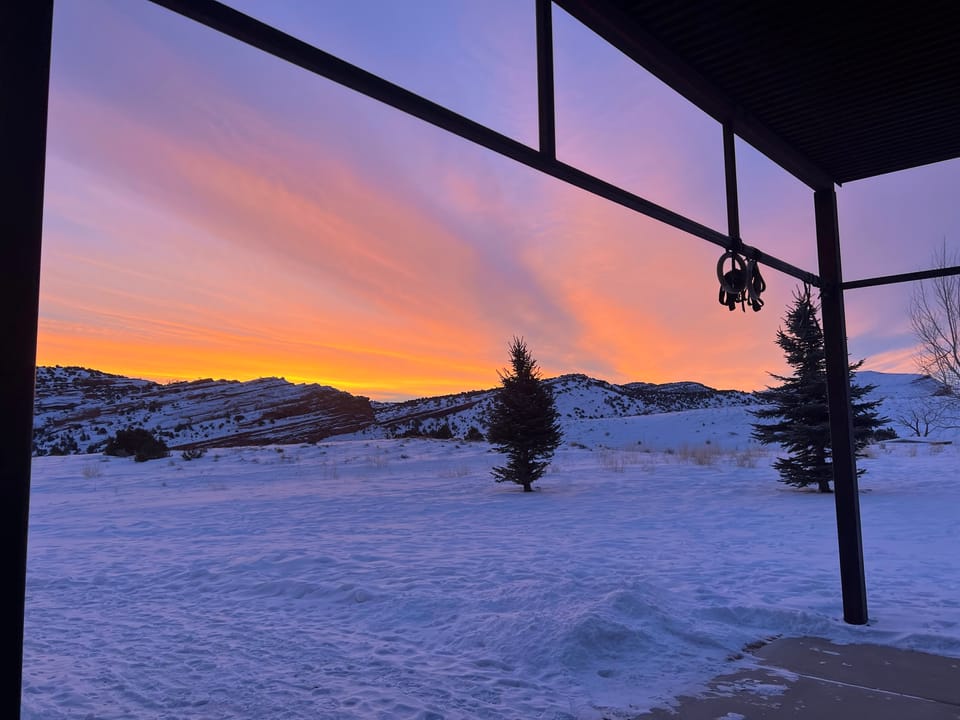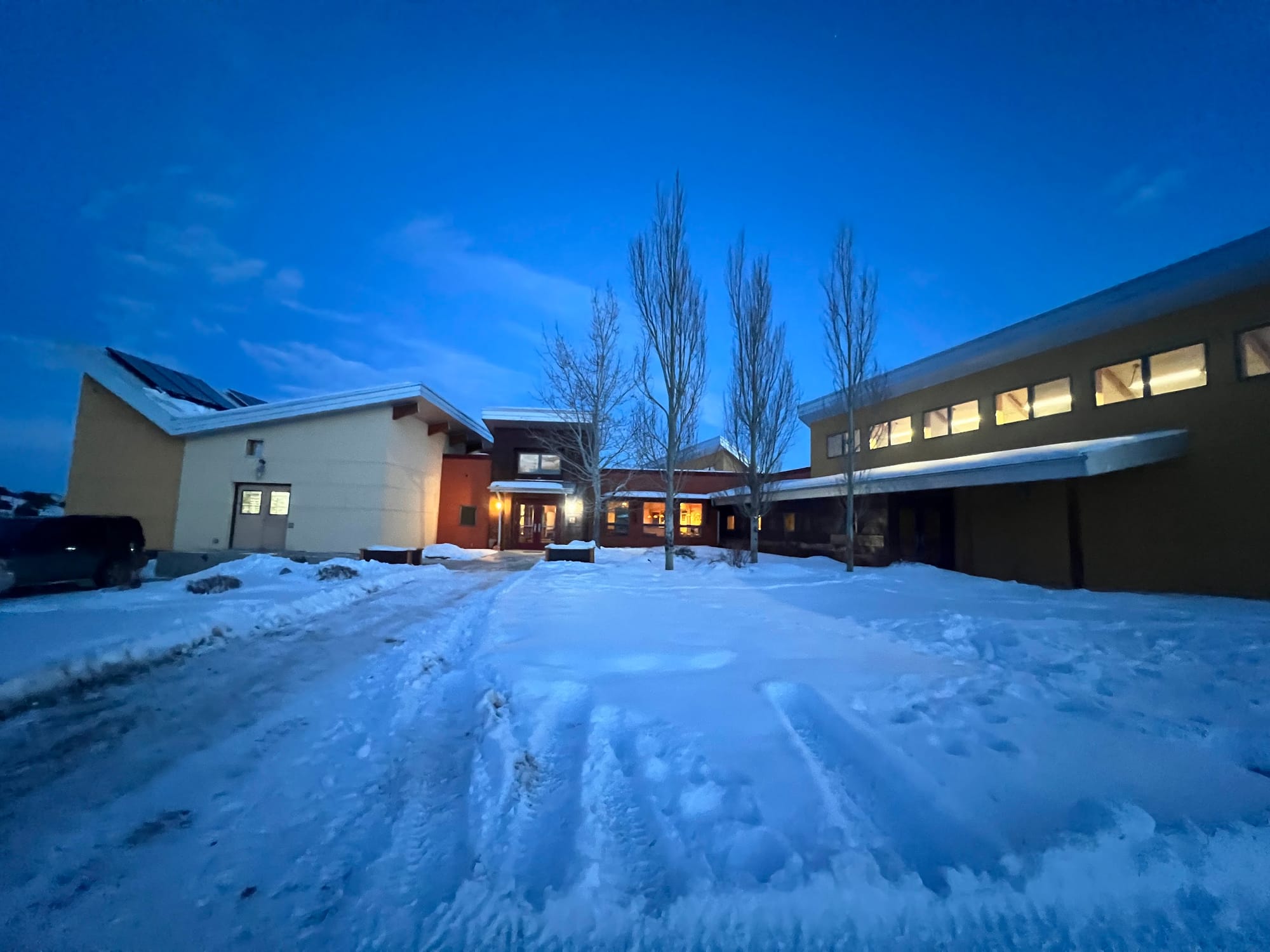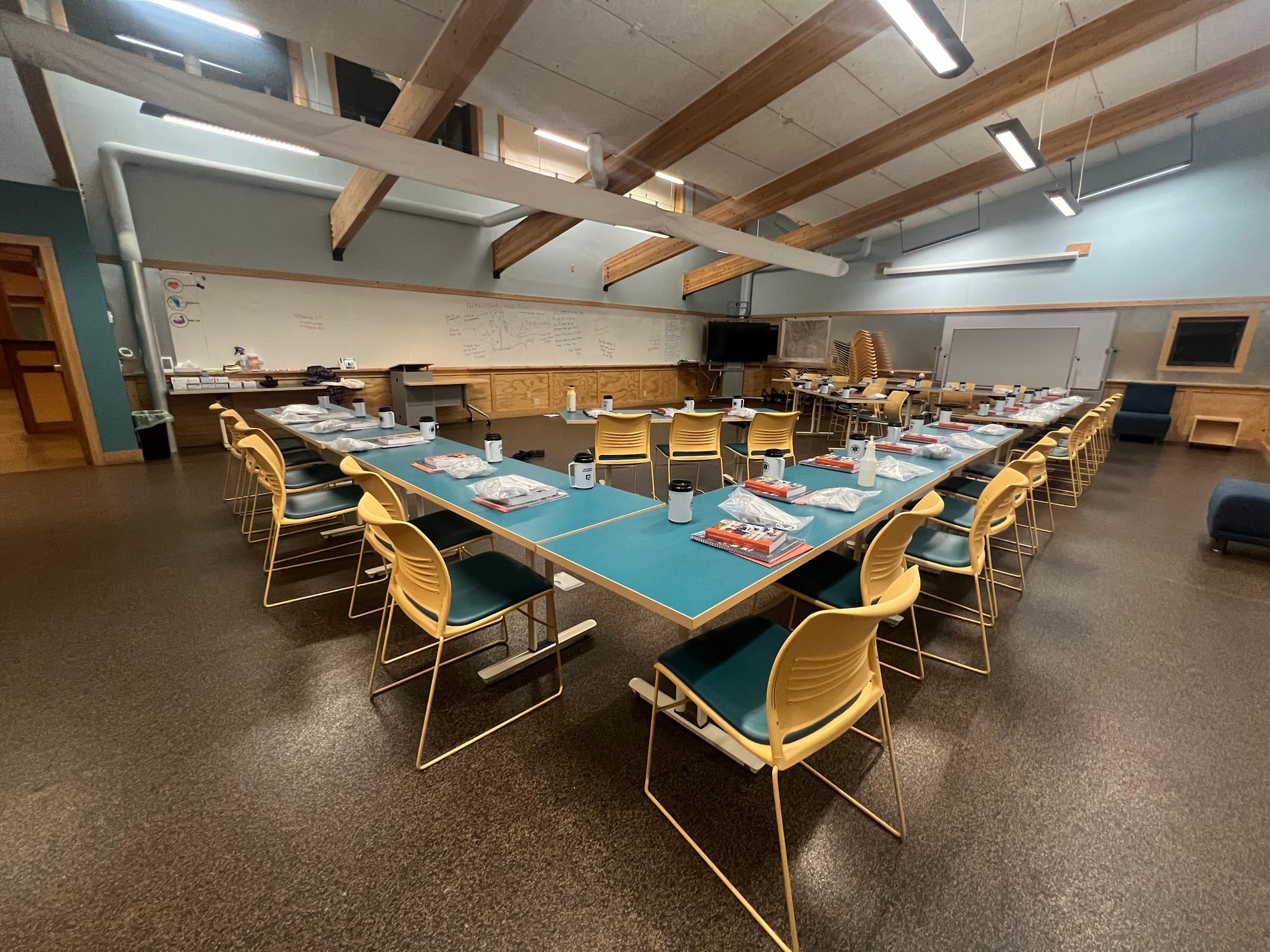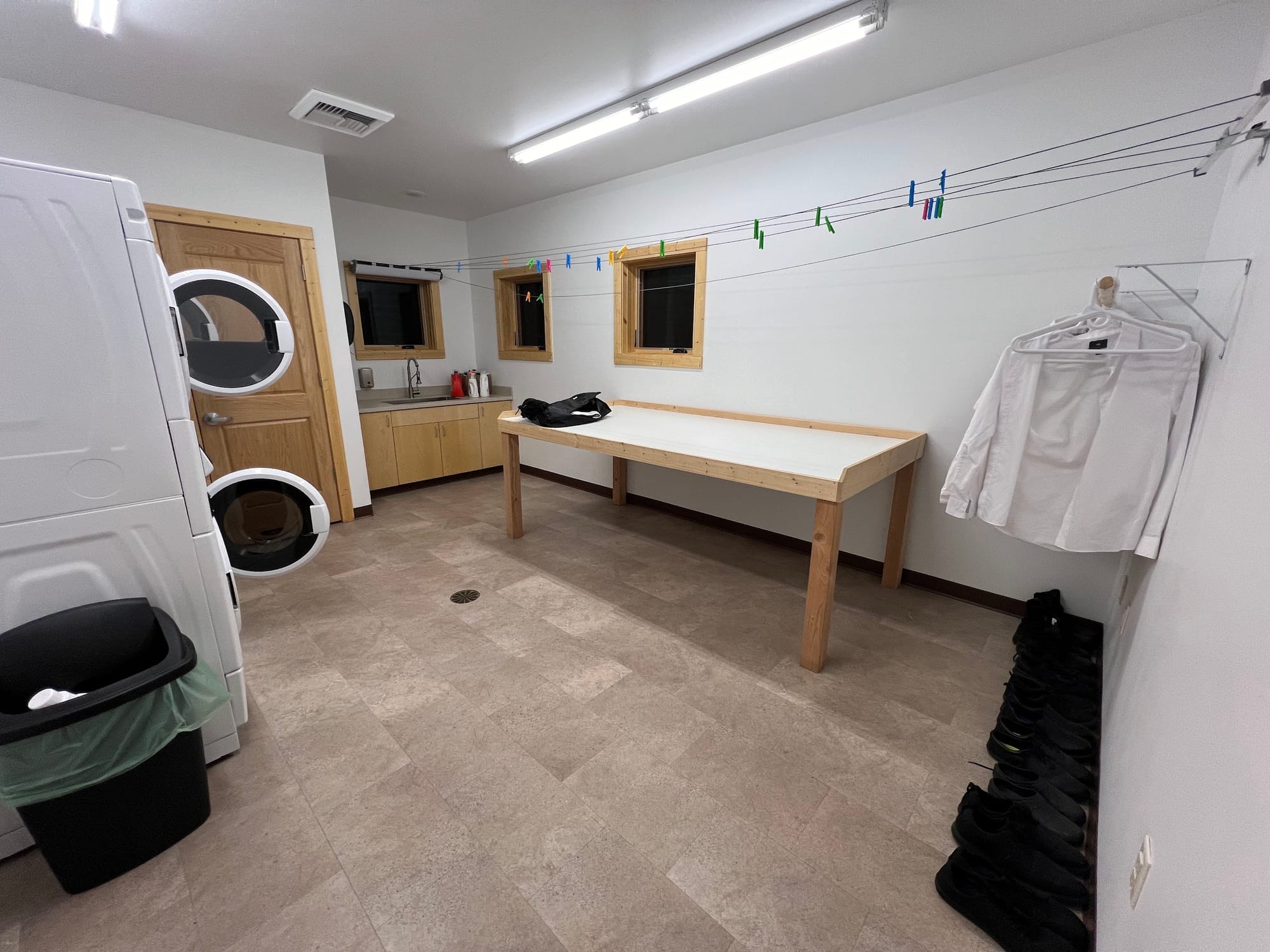Course Review: NOLS WEMT, Part 2 - Logistics

This blog post is part of a series. See also:
- Course Review: NOLS WEMT, Part 1 - Overview
- Course Review: NOLS WEMT, Part 2 - Logistics (you’re here)
- Course Review: NOLS WEMT, Part 3 - Advice
Summary
- Take the NOLS WEMT course (which is based in Lander, Wyoming) in winter for an additional challenge, in September/October for the most pleasant conditions, or another month for somewhere in between.
- Prerequisites are due 45 days before course start. Start on the required vaccinations, background check, drug screen, etc. early to ensure you can make your intended course date.
- Students reside in cabins of up to 4 people, with up to 2 people per room. Each cabin is joined to another cabin for up to 8 people per building.
- Food is prepared for you on weekdays, leftovers can be reheated on the weekends, and it’s all delicious. There is free laundry in the student center, which also has a minimal gym and study spaces.
- For non-winter courses, bring clothing appropriate for 3-season backpacking. For winter courses, bring layers that you would use for a winter backpacking trip via snowshoe. Do not bring climbing gear, tents, skis, snowshoes, etc. unless you plan on these activities during your (very) minimal free-time.
- Absolutely do bring the 10 Essentials in a daypack (up to ~30L is best). Bringing warm indoor slippers, waterproof notebooks, a sit-pad, knee-pads, a stethoscope, and a blood pressure cuff will also make you more successful. See also the NOLS packing list. Pack light otherwise.
Getting There
One of the biggest knowledge gaps I had coming into this course was how the life logistics would work. NOLS does provide a lot of guidance if you click through to a specific course's details page. From the NOLS WEMT overview page, click on "Enroll now" for the dates you're interested in, and note the additional documents now linked under "Important Course Information". I also searched around online for other reviews of this course. Still, nothing had the level of detail I wanted. So here are those details.
Prerequisites
First, there is a long list of time-sensitive prerequisites for this course. See “~WEMT Required Prerequisites~” from the course overview page. Review them to make sure you can handle them all by >= 45 days before the first day of your intended course. You should target 60 days to give yourself fudge time for administrative hiccups.
At a high level, the prerequisites are:
- Vaccinations. This is the most common logistical headache for students. Some immunizations require a 1-month spacing between shots, so plan ahead and get started early, or else you will have to take a later course. If you’ve lost your childhood yellow card, see if your state has an immunization registry from which you can pull your records. Otherwise, you’ll have to take blood tests (titers) that show you have antibodies in your blood to the relevant pathogens. For any missing immunity, you can visit a combination of your local travel clinic, CVS, and/or Walgreens for vaccines.
- CPR certification at the Basic Life Support (BLS) level from the American Heart Association (AHA) only. No other providers are accepted.
- A criminal background check. Speak with a NOLS admission counselor if you’re unsure whether your record precludes enrollment. Note that NOLS’ partner hospitals and the National Registry of Emergency Medical Technicians (NREMT) have their own standards for what is considered acceptable.
- A drug screen, which is done via a urine sample.
- A tuberculosis blood test. This is now a QuantiFERON blood test only, so skin tests will not be accepted.
Timing
Take this course in the summer if you're already e.g., an experienced ski patroller and/or want more fun downtime. There's a nearby creek (5-10 feet wide and up to ~5 feet deep) that flows even during the depths of winter, so it would be a refreshing dip in warm weather.
Take on winter if you are seeking a serious challenge. Do a shoulder season if you're in-between or don't have a choice on timing. Note that this course normally fills up ~3 months in advance for each offering, so plan ahead.
You'll want to check the average conditions when picking a course and the National Weather Service provides a wonderful spot forecast tool.
Transportation
On Google, the campus is labeled as the “Wyss Wilderness Medicine Campus” at 222 Red Canyon Rd, Lander, WY 82520. The Google Plus Code is “M8VJ+J8 Lander, Wyoming”. This is about a 20-30 minute drive from Lander proper.
The coordinates [coordinate-systems] of the roundabout (with 1 meter of precision and using the WGS84 datum) in front of the main building are:
- Decimal degrees: 42.69419, -108.66910
- UTM: 12T 0690932E 4729491N
- USNG/MGRS: 12T XN 90932 29491
To get to the campus, you can drive or fly in. For flying, you’ll need to choose between Casper (CPR) or Riverton (RIW), then take a shuttle to/from campus (booked separately via Wyoming Share-a-Ride).
Campus housing will not be available if you arrive earlier than the afternoon the day before class starts (e.g., after 2 PM on December 31 for a January 1 class start) and you cannot stay overnight past the final day of the course. For departure, some flights leave as early as 5 or 7 AM. There were shuttles available for these, but confirm in advance with the shuttle company.
If you do need to arrive early or stay later, you’ll need to do so at a hotel in Lander. NOLS’ course logistics document has all the details. In general, you will need to be on top of your planning here to avoid last-mile travel nightmares.
The Campus
If you're taking this course, you probably also love maps, so here's a bird's eye view of the campus using Felt, one of the best GIS (geographic information system) tools ever:

Main Building:
- 2 classrooms (black and red)
- Kitchen and dining area
Student Center:
- Laundry room
- Mini gym
- TV lounge
- Study loft
- Conference room
For studying, I recommend individual sessions in your cabin, and group quiz sessions in the student center. The main building classroom varied on whether it was quiet (the default) or social during after-hours. With the exception of practical testing day, you will have 24/7 access to your cabin and both campus buildings. That includes all of the practical equipment for skills practice.
Bonus: if the head of facilities is available, you can ask them for a tour of the basement to see the awesome sustainability infrastructure that NOLS invested in: composting toilets, rainwater collection, solar panel controls, etc.
Some photos (I've omitted any that include classmates' faces as a standard privacy precaution):




Housing
NOLS charges a pretty penny for this course but food and housing is included. There are two sets of student cabins that are connected by short trails to the Student Center and Main Classroom. There are usually two WEMT courses in-progress at once, each using one of the classrooms and set of cabins.
You'll have up to 4 students in a cabin, split between a double, a single and an upstairs loft. First-come, first-serve for picking your room. Not every cabin had this many people, and some dropped down to just 3 people after some departures, so every person in those had their own room. Be a good roommate!
For cleaning supplies, there is hand soap, plenty of spare toilet paper, disinfectant spray, and a broom + dustpan. Additional trash bags will need to be sourced from supply closet in the dining area (ask the kitchen staff).
The cabins are very well-insulated and have infrared bars + thermostats for heating. The bedding is minimal, with a thin spring mattress, a thin memory foam topper, a top sheet, a single pillow, and a pillow-case. The rooms won't drop below 50ºF even if it's -20ºF outside and you can't figure out the thermostat, so you'd be fine with ~any sleeping bag.
You can also consider going bougie like I did and order an electric blanket and extra pillows. After all, sleep is key during such an intense course and you are there for an extended period of time. I left these items behind in the laundry room for the benefit of future students.
I only have a few images of the housing as I was heads-down studying when here. The Nalgene bottle below is a standard 1-liter wide-mouth for size reference. There is a common space area with a couch, comfy chair, and coffee table that is not pictured.




Food
The food is delicious! If you associate formal education with terrible food, don't worry, this was the opposite. By way of comparison, the food was comparable to the food quality at Stripe, which in turn was 90% of the quality I had at UCLA, which is top-ranked in the country for its residential restaurants ("dorm food" is a gross understatement). All three would rank below a Bib Gourmand listing (UCLA just barely). Overall, I am used to excellent food and was pleasantly surprised with the offerings I had during this course. You will probably gain weight during this course.
Breakfast was pretty consistent: eggs (fried, scrambled, etc.), oatmeal/grits, some form of carbs (pancakes, waffles, French toast, etc.), and freshly cut fruit. Lunch would always have a salad bar, paired with entrees like tacos, Thai noodles, or burgers. Dinner would again have a salad bar. Example entrees here include fried rice, pastas, and savory pies. The menu rarely repeated for lunch/dinner during the course. Cuisines varied and were way more than what I was expecting from Wyoming.
You'll be asked for any dietary restrictions in advance and the kitchen staff went out of their way to ensure everyone was covered for every meal. All items were always clearly labeled and they would often individually consult with folks to double-check the scope of a restriction. During our course, the entire campus went shellfish-free throughout, as one student had a severe allergy to shellfish. It would have been ironic for someone to suffer anaphylaxis during a WEMT course.
If you don't have a dietary restriction, please leave specially marked food (vegan/gluten-free, etc.) alone until everyone—including the other class—has passed through the food line before getting some.
Also: there's no need to cook on the weekends. You can cook using the stovetop, microwave, sink, etc. in the student kitchen, but I recommend against this unless that’d be a helpful destressor. Leftovers will be stored in one of two massive fridges. Reheat and eat that on the weekends (again letting specially marked items be eaten by the folks who need them first). That was a massive relief for me, as I hate cooking when I could be studying. You can also go to town for its grocery stores and restaurants, but don't expect to have much time for this.
Lastly, there's a lovely outdoor deck area for lunchtime seating that we ~never used in the winter but that would be so pleasant during the other seasons.
Laundry
There is a laundry room with 3 washers and 3 dryers. They are free. Do laundry earlier in the day on weekends or on weekday evenings to avoid congestion.
There was a large collection of leftover detergent when I was there, so you're probably okay if you forget that on your way in. Don't rely on this. I just brought a couple 8 oz bottles of Dr. Bronner's do-everything soap, and I did not exhaust either during the month.
There was also a large set of left-behind white shirts and black shoes for clinical rotations. If you don't like the ones you brought, you may be able to find better ones, but again, don't count on this.
Gym
There is a small, spartan gym in the student center: 1 squat rack / bench press, 1 hang-board, 1 TRX strap, 1 row machine, 1 yoga mat, 1 pair of boxing gloves, and 1 foam box for box jumps.
There are also gymnastic rings and a pull-up bar outside of the classroom. A few classmates and I would often be out there to do push-ups and pull-ups to warm up before quizzes or during breaks.
My classmates were dedicated and working out after class from Day 1. I was not as consistent as I wanted to be, and I regret not doing more trail runs in particular, despite the snow. I did go for hikes, as did most of the class.
Lastly, I regret not doing a polar cold plunge while I had the chance. If you do a winter course, bring a change of clothes and a rewarming kit (towel, mylar blanket, warm water in a bottle) to the creek.
What to Bring
NOLS gives a full gear-list. I'll focus on the pieces that I most appreciated during this course, especially as someone who hadn't been in subzero temps before.
I’ll reinforce upfront that you should have the 10 Essential Systems on you at all times when outdoors, and that includes the patient-care scenarios in this course. The longer ones go further away from the classroom and you should be prepared for the elements.
Know also that you can order packages to the Wyss Campus if you forget something or need something else, so there’s no need to go over the weight limit on checked baggage or bring a bulky pillow. Again, the course logistics doc has these details.
Layers
This was another area where I spent a lot of time research and comparing options. For a winter course, reuse any clothing you already have for resort skiing, winter backpacking, and mountaineering before buying new things. In general, this course is mostly static, with some light hiking, and won't have the heat output of e.g., a ski touring or ice climbing trip. Lean towards warm and waterproof (while retaining moisture management) and don't worry about weight.
Know that these are particularly important to get right: base layers (merino wool and sun hoodies), boots (insulated and broken-in beforehand), gloves (see details below), and your outermost layers (waterproof, as you'll be laying/kneeling/sitting in snow for hours).
The list below is for a winter course with temperatures down to -20ºF. For a non-winter course, just bring standard 3-season backpacking layers. You won't need e.g., a belay parka, ski gloves, or insulated boots.
| Layer | Recommendations | Notes |
|---|---|---|
| Base layers | Lightweight and midweight merino wool (top + bottom) Sun hoody (UPF 50) |
3-4 pairs of merino wool is best: 2-3 to rotate through between laundry loads, 1 for sleep. A sun hoody is great for more active days. Apply Permetherin to everything in advance if you're doing a non-winter course. |
| Lightweight mid-layers: | Fleece/PolarTec pullover Synthetic puffy with a hood |
Bring both to enable layering. |
| Warmer mid-layers | Down puffy with a hood Down pants |
Definitely bring down pants for a winter course. |
| Storm layers | Hardshell jacket Hardshell pants/bib |
Waterproof rain pants also work and I liked how easy they were to slip on/off during the course. Waterproof bottoms are a must in general. Wash + reapply DWR to everything in advance. |
| Outermost layers | Belay parka (guaranteed to have a hood) | I went with the Rab Neutrino Pro, which sufficed for this course. In retrospect, I would have preferred the Rab Positron Pro (10 oz / 283 g of 800 FP down) or warmer (see Feathered Friends). That would have given optionality for winter summits of 14ers and higher. |
| Gloves | Liner gloves Lightweight waterproof gloves Midweight waterproof gloves Optional: heavyweight mitts |
You want to be able to layer up/down depending on conditions and your need for dexterity. “Lighweight” here means typical foul-weather cycling gloves. “Midweight” here means typical ski gloves. Bring insulated mitts and handwarmer packets if your hands often run cold. |
| Boots | Insulated, waterproof, and tall (>= 6 inches) | The easiest-to-use design for this course specifically would be one that slips on/off quickly, but you also need to be able to hike with it. Some people brought slip-on boots and hiking boots. I wore North Face Chilkat V 400 boots for the entirety of the course, including during my clinical rotations. Mountaineering boots would also work, but are overkill for this course. |
| Socks | Merino wool | I wore Darn Tough mountaineering socks and loved them. Go down in weight as appropriate to the season. |
| Beanie | Warm and ear-covering | I particularly love the OR Wind Warrior since it also blocks wind. |
| Hat | Baseball cap | Wide-brim hats or ones with a neck flap will struggle in the winter winds. Get sun protection for your neck via a hood or neck gaiter instead. In warmer 3-season conditions, my recommendations would flip. |
| Neck gaiter | UPF 50 and quick-drying | I much prefer the extra material and stretch of Blackstrap ones over Buff, as the latter chokes me. Consider a balaclava-style design, as this will slip down far less often from over your mouth, but is less versatile for non-winter contexts. Remember to bring/order sunscreen as well. I recommend mineral-based ones that are reef-safe. I personally use Thrive every day. |
| Sunglasses | Rated for full "UV400" or "100% UVA/UVB" protection. | Wraparound is best due to the snow. Glacier sunglasses are nice if you already have them but are unnecessary for this course, as the longest scenarios take place while the light is diminishing/gone. I now wear NoCry safety sunglasses (over-glasses version) when outside and they would have been perfect. You could also get the clear NoCry safety glasses (no point to the over-glasses version for this course) for less sunny days if your eyes dry out with wind, are sensitive to dust, etc. |
| Hand warmers | Individually packaged and air-activated | These came in clutch for saving toes and fingers. |
| Headlamp | Remember to bring extra batteries and/or charging cables | Everything you learn, you should be ready to perform in the dark. |
| Optional items | Traction devices Gaiters |
Traction devices are helpful during the longer hikes. I specifically recommand the Kahtoola MICROspikes for boots and EXOspikes for trail-runners. Gaiters are useful for boots <=5 inches high during winter. courses. |
You can skip: soft-shell layers, both top and bottom. With the exception of the litter carries, you won't have enough athletic output to hit the protection/breathability sweet-spot that these layers target. You can also leave behind your trekking poles, unless you plan on extensive hiking as part of your downtime. I found I never used mine, as the day-hikes I had time for on the weekends weren't long enough to warrant them. And during scenarios, you’ll need both of your hands free. Lastly, you won’t need any climbing gear (helmet, harness, etc.), as this course is focused purely on medicine. For technical rescue training, see the NOLS Wilderness Medicine and Rescue semester instead.
Note: the down pants are particularly key for the night scenarios. I wore everything listed above (minus down pants, which I forgot) and started feeling cold toes around 3 hours in. Those who had fewer layers were cold after an hour or two, or even suffered superficial frostbite, mainly to their hands or toes (I have more thoughts on how to prevent frostbite in the Critiques section). Classmates who brought down pants never felt cold.
Gear
First, bring a daypack (10-30L) to hold everything. Remember a rain cover so that you can set it down in the snow/mud without worry. You won't need anything larger than this, as there are no (planned) overnights outdoors during the course.
Second, get Rite in the Rain (RITR) notebooks and pens. I recommend the 11 x 8 inch size for the classroom and the 5 x 7 inch for hospital rotations, both the with universal grid pattern. The snow will turn regular paper into a wet mushy mess. RITR notebooks can just be tossed into slushy snow and then picked back up and written on without issue.
Third, a sit-pad is a fast way to get your butt or knees off the snow during scenarios. This adds a surprising amount of comfort and warmth. It was my favorite item during scenarios.
Fourth, bring kneepads to make kneeling during scenarios and testing infinitely more comfortable. Trust me, they’re worth it.
Fifth, get your own stethoscope and blood pressure cuff. The classroom stethoscopes are well-worn. They're hard to hear for blood pressure readings and it is very difficult to distinguish lung sounds with them. I specifically recommend the Littmann Classic III. I found it to be 2-3x louder than a Classic II S.E and 5x better than the classroom beaters. To my non-cardiologist ears, there was no discernible difference vs a Cardiology IV for heart and lung sounds. Why Littmann? They are the current gold standard. Your own healthcare providers almost certainly use a Littmann. I have no commercial relationship, and wish there were more effective competition. It's just the current state of the stethoscope market. As for the blood pressure cuff, that’s just for convenience, to skip a trip back to the classroom for getting one for practice.
Lastly, I recommend making class swag! We made t-shirts and ours came out rad, courtesy of one of our classmates having been a professional designer in tech for ~15 years.
Footnotes
[coordinate-systems]: If you haven’t seen UTM (Universal Transverse Mercator), USNG (United States National Grid), or MGRS (Military Grid Reference System) before, these are coordinate systems. They’re ways of specifying a place on the Earth (though USNG is undefined outside of the US).
You do not need to know coordinate systems for this course, but they are worth learning for backcountry travel in general. UTM-based coordinate systems are far easier to use in conjunction with a map.
If your phone or your GPS device tells you're at 35°39'14", -83°32'56", can you find that on the map? 35.65382, -83.54877 is even worse! But if your GPS is set to UTM and it displays 17S 0269267E 3948547N, you can quickly find this on most topographic maps using the built-in grid lines.
This also helps when you're planning a trip at home. You’ll be able to precisely map out a course using software like CalTopo or Gaia, and then find the exact same waypoints on a paper map to mark them up.
Being able to stay found becomes especially crucial if you go off-trail and is a key way to avoid becoming lost even if you stay on-trail. Why is this valuable if your phone can just show you a virtual map? Because its battery life will extend far longer if you're just turning on your phone to get coordinates rather than using virtual maps. And on a device like an inReach Mini, you won't have a virtual map, but you can still get a GPS fix and coordinates.
If you’d like to go down this rabbit-hole, start with the tutorials from MapTools.
Meanwhile, you should at least know how to get coordinates from a compass app on your phone if you ever need to call 911 (112 in Europe). These will probably be in Degrees Minutes Seconds (DMS) or decimal degrees (DD.x) of latitude/longitude. Emergency dispatch will be able to handle converting the coordinates using software like Earth Point or Spyglass.